Carbohydrates and Cancer: Are Starchy Foods Linked to Cancer?
Have you ever wondered why some low carb diets tell you to avoid certain vegetables? Vegetables are healthy, right? Well, it is a little more complex than just eating your veggies. And that is because vegetables contain dietary starches. These complex carbohydrates follow different paths in your body, making healthy eating a complex and controversial topic. I explore dietary starches in this article, including how this complex carbohydrate can influence health and cancer risk.
“Eating healthy food fills your body with energy and nutrients. Imagine your cells smiling back at you and saying: Thank you.” – Karen Salmansohn
As a breast cancer survivor, I wanted to eat as healthy as I could. I knew there was a link between food and disease, and I wanted to eat foods that could help improve my health. And over the years, I found that eating a healthy diet, full of nutritious whole foods, has helped me feel better. I have more energy, I handle stress more easily, and my mood is more balanced when I eat well. So, now I want to share what I have learned with you.
The role of carbohydrates and cancer is an extraordinarily complex topic. So, I divided it into a 3-part series. Please read all three articles to learn what medical and scientific research currently tell us about carbohydrates, health, and cancer.
Part 1: Carbohydrates and Cancer: Does Sugar Feed Cancer?
Part 2: Carbohydrates and Cancer: Does Fiber Fight Cancer?
Part 3: Carbohydrates and Cancer: Are Starchy Foods Linked to Cancer?
What is a Carbohydrate?
Carbohydrates (carbs) are one of the dietary macronutrients we eat. There are three major groups of carbs in foods: sugar, fiber, and starch.
Simple carbohydrate molecules, such as glucose, are quickly used for energy or are stored in our bodies. But the larger, complex molecules are the important dietary fiber and starch molecules that have many functions in your body.
Let’s quickly recap what we talked about in Part 1 and Part 2 of this series on Carbohydrates and Cancer.
Sugars
In Part 1, I explore sugars with you. And while cancer cells use more sugar than normal body cells, eating sweet foods does not make cancer worse. Eating sugar will not make cancer grow faster in your body. But eating a lot of sugar, over time does increase your risk of getting cancer, and other illnesses.
Reducing the amount of added sugars consumed every day can lower the risk of developing many diseases, including cancer.
Dietary Fiber
Part 2 talks about the importance of getting enough dietary fiber in your diet. Fiber is the large, indigestible carbohydrate molecules that feed our gut microbiota and help detoxify our digestive system. Studies suggest that fiber may help prevent some cancers.
Eating just 2 ½ cups of vegetables a day can give you all the dietary fiber you need.
Dietary Starches
The last major group of carbohydrates in this series is dietary starches. Like fiber, starches are complex molecules containing strings of simple sugars linked together.
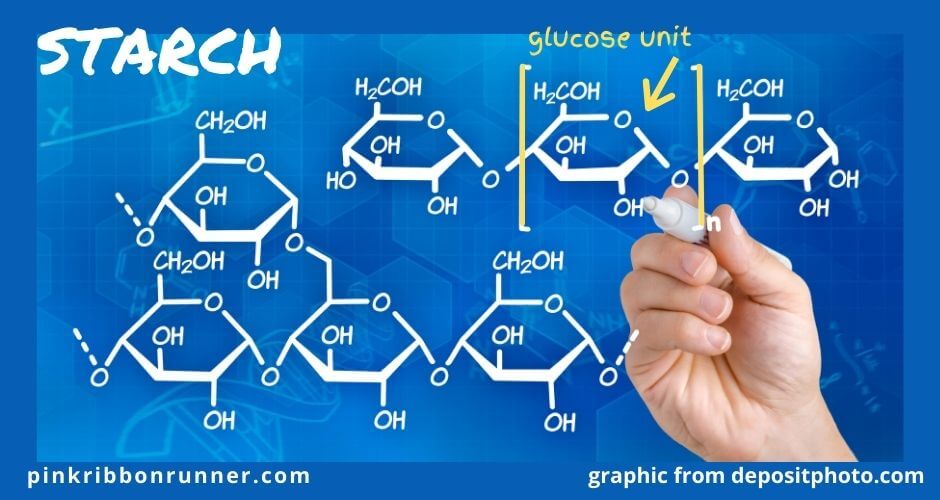
Some starches are broken down during digestion into glucose and other single sugar units. These types of starches will raise blood sugar. So, they act like the sugars we talked about in Part 1. Thus, these molecules are said to have a high glycemic index, meaning that they can raise blood glucose levels to trigger insulin release.
“Glycemic Index is a system that ranks food on a scale of 1 to 100 based on their effect on blood sugar levels” – Oxford Dictionaries
Other starches are not easily broken down during digestion. These starches are called “resistant starches”. They act similar to dietary fiber molecules. They ferment in your digestive system to make beneficial postbiotic molecules.
What Do Cancer Cells Feed On?
As Part 1 explains, cancer cells do eat a lot of sugar. They eat more sugar than the normal cells in your body. Doctors take advantage of this by adding tracers to sugar molecules. The cancer cells gobble up this tagged sugar and light up images on MRI, CT and PET scans. Your doctor can then tell where any cancer is in your body.
But this doesn’t mean that you are feeding your cancer by eating sugar. And you cannot starve cancer by not eating carbohydrates. To do this would also starve your healthy cells and leave you feeling sluggish, tired, confused, and ill.
Besides, cancer cells also use other macronutrients, such as protein and fat. So, you can’t really starve cancer by just cutting out sugar anyways.
What does any of this have to do with dietary starches? Well, the starch in some foods can be broken down during digestion into base sugar units. These base units are essentially sugar molecules. So, some starches are digested to make glucose, or blood sugar. And the starch that is broken down like this behaves in the same way as sugar does.
What is the Link Between Starchy Foods and Cancer?
A food with a high glycemic index will trigger insulin and other hormones. Some starchy foods have a high glycemic index because they break down into simple sugars. And too much of these starchy foods over time can also raise the risk for some cancers, just as sugar does.
But wait! There is some good news. There are also starches that don’t break down completely. Recent scientific studies suggest that these resistant starches may help prevent some cancers, especially colon cancer. The probiotic bacteria in your gut help to ferment these hard to digest starch molecules and produce by-product molecules, such as butyrate, that may help fight cancer.
“enzyme-resistant starches pass through the upper digestive tract to the colon, where they are fermented by bacteria, producing important metabolites. These metabolites appear to have important biological effects, including reduction of colon cancer precursors, systemic regulation of macronutrient metabolism, and altered secretion of hormones, which can lead to improved physical and mental health.” – American Society for Nutrition Journal
Should I Avoid Starchy Foods?
There is not a simple answer to the question of whether or not you should avoid dietary starch. As we have discussed, some starches raise blood sugar, but some do not. And since starch is the main storage form in plants, it can be near impossible to avoid starches altogether. You should eat your veggies.
We know that eating vegetables and fruits are healthy, as they are packed full of powerful antioxidants, vitamins, minerals and a wealth of other healthy compounds. You certainly don’t want to be limiting your intake of these just because they contain starches.
But some starches are less healthy than others. Potatoes, wheat, white rice and corn are starchy vegetables that you may want to limit in your diet. You want to eat more of the vegetables containing the most nutrients and resistant starches.
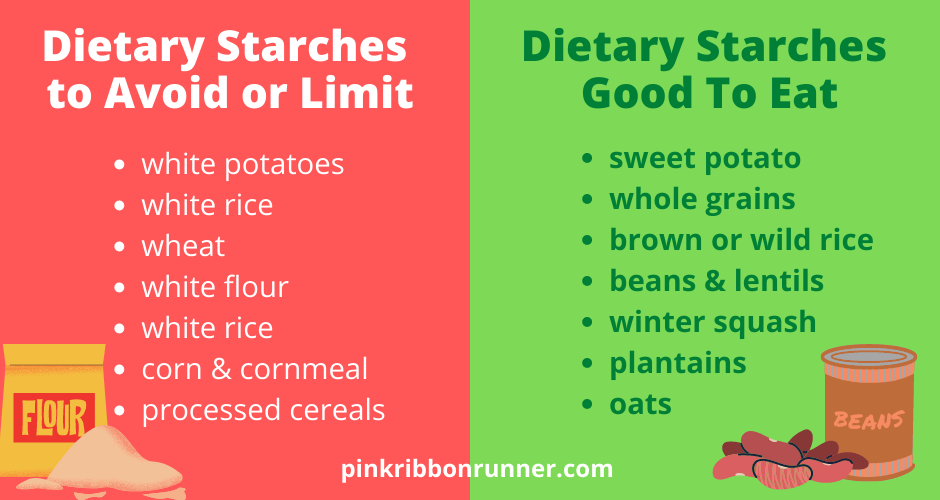
What are Resistant Starches?
So, what exactly are these beneficial resistant starches anyways?
They are called resistant starch because they resist digestion. They aren’t broken down into simple sugar units like other digestible starches. Instead they act more like fiber does. They ferment in your intestines to make postbiotic molecules. It is these post-biotic molecules that have a beneficial effect on your health.
There are four basic types of resistant starches:
Type 1:
This type of starch is trapped inside a thick cell wall. This wall protects the starch from digestive enzymes. It is the type of starch in seeds, cereal grains, and durum wheat. Grinding or milling can remove the protective wall and make the starch more digestible, and less healthy.
Type 2:
Foods with type 2 starches include potato, green bananas, gingko and corn. The starch molecules are shaped in such a way that enzymes cannot break them down. When eaten raw, these starches are resistant. But after cooking, type 2 starch is broken down and becomes digestible.
Type 3:
Type 3 starch is retrograded starch. These starch molecules are not broken down by cooking. Instead, when they cool, the starch molecules realign and form crystals. Retrograded starch is not as digestible and, thus, healthier. Cooked and cooled potatoes, pasta, rice and bread form this type of starch.
Type 4:
Type 4 starches are those that have been chemically modified to produce cross-links in its chemical structure. These cross links prevent digestive enzymes from breaking them down, thus making them resistant to digestion.
So, as you can see, starches can be manipulated in the way they are stored, cooked, cooled, and chemically altered to form less digestible starches, which can be beneficial to your health.
How Do I Tell Good Starches from Bad Starches?
Some examples of starchy vegetables you should limit include potatoes, wheat, and corn. The more processed these are, such as in flour or cornmeal, the higher the glycemic index and the more they should be limited.
The better choices of starch are beans, lentils, sweet potato and squash. When eaten as whole foods, the higher amount of fiber lowers the glycemic index. They also have more vitamins and minerals per calorie than the other starchy vegetables mentioned above.
You want to eat more of the vegetables that are on the medium to low scale of the glycemic index. These vegetables tend to contain less digestible starches. Limit the amount of high glycemic veggies, if possible. Or find ways to make the starch they contain less digestible, such as cooking and cooling potatoes in potato salad, for example.
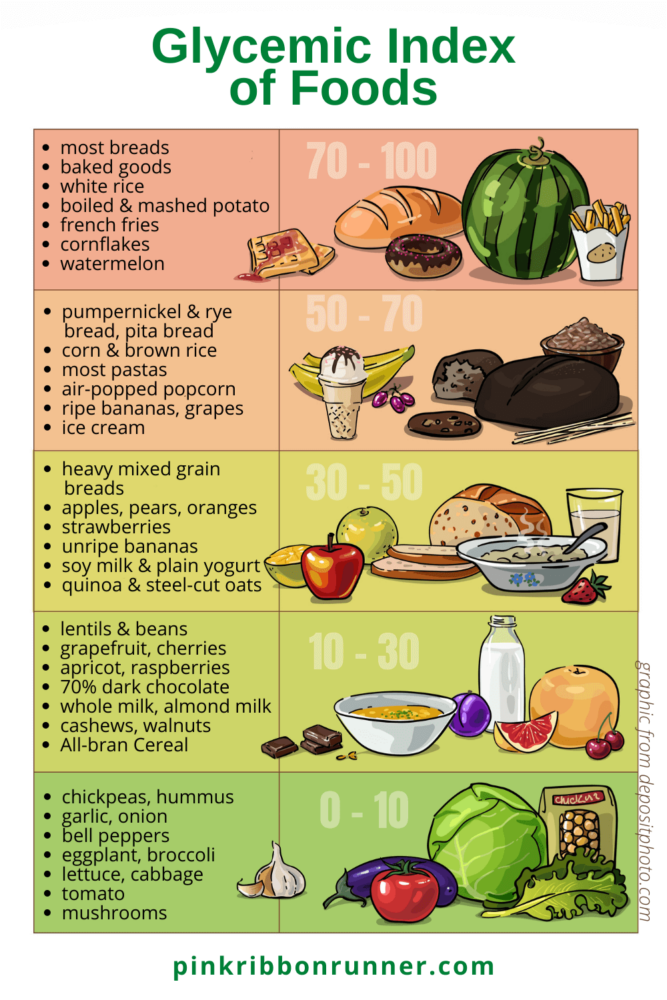
A Note about Glycemic Index of Foods
The glycemic index of foods is not a fool-proof way of determining what is healthy or not. You may have noticed that watermelon has a high glycemic index. But, unless you are diabetic, watermelon is healthy to eat because it also contains other great nutrients. So, glycemic index isn’t a measure of how healthy a food is, it is just a measure of how that food affects your blood sugar levels.
Other foods, such as milk and ice cream, that contain little starch, are also given a glycemic index number. This is because glycemic index accounts for total carbohydrates, not just starches.
Some studies suggest that diets high in foods with a high glycemic index may increase cancer risk for some types of cancer, but not others. It is clear that more research is needed.
So, use glycemic index as a rough guide on which starchy foods are healthier. Stick to less processed foods that won’t spike your blood sugar levels drastically. Eat foods that contain more of the resistant starches. And if you do choose foods higher on the scale, make sure they pack a powerful nutrient punch in other ways, or eat them in smaller amounts less frequently.
How Does Cooking Affect Dietary Starch?
As we saw, the type of starch in the food can be manipulated to make it more or less digestible. So, keeping this in mind, there are things you can do to eat more of the better resistant starches.
7 Tips for Cooking and Eating Starchy Foods
- Cook with more whole grains and less milled flours or ground seeds.
- Eat more raw unripe bananas than yellow or spotted bananas.
- Avoid cooking foods such as oats and plantains that form more digestible starches when heated.
- Heat and cool foods such as potatoes and rice to allow more resistant starches to form.
- Eat more foods with a lower glycemic index.
- Learn how cooking can influence digestibility of the foods you eat routinely.
- Eat less processed foods, as these tend to have more digestible starches that can spike blood glucose and insulin.
How Much Starch Should I Be Eating?
There are no official guidelines on how much starch you should eat in a day. This is likely because it is a complex topic, as we have just seen. There are digestible starches and resistant starches, which can be manipulated during processing and cooking. It can be safe to assume that you should try to eat more resistant starches, as these are the ones that may have a health benefit.
Most guidelines, such as the Dietary Guideline for Americans 2020, are moving away from recommending specific amounts of these macronutrients. In the past, the recommendation was to eat 45% to 60% total carbohydrates. But as we have seen, this doesn’t distinguish good carbs from bad carbs. Theoretically, based on this guideline, you could eat 60% of carbs as sugars and digestible starches, which is not a healthy diet. You should be eating more fiber and resistant starches for optimal health.
So, instead of relying on percentages and numbers, most dietary guidelines state that you should eat ¼ of your plate in protein, ¼ of your plate in grains (fiber and resistant starches) and ½ your plate in vegetables and fruits. Vegetables and fruits in this context provide a range of sugars, starches, fats and proteins depending on which ones you choose. For this half of your plate to be healthy, you should choose a variety of colorful veggies and fruits to enjoy.
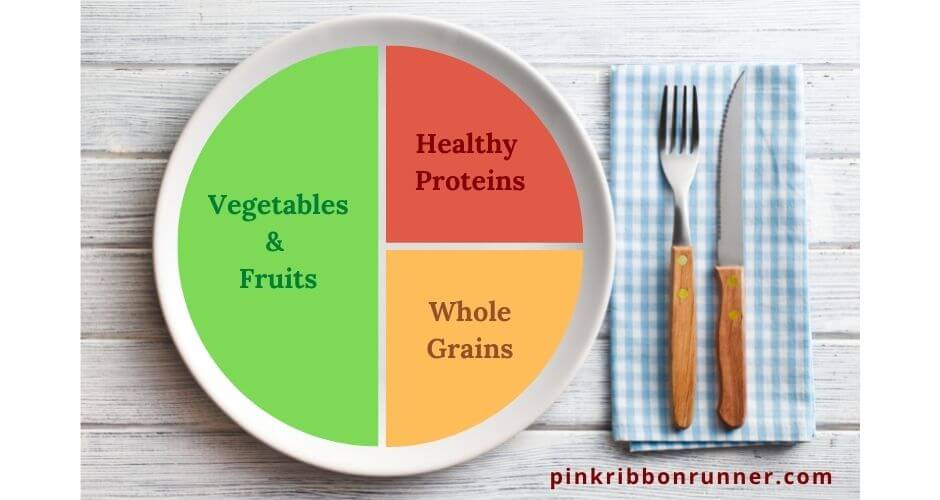
It is also important to recognize that individual requirements do vary. You should talk to your doctor or dietitian about your personal dietary requirements based on your health status.
Should Cancer Patients Avoid Starchy Foods?
“Although research has shown that cancer cells consume more sugar (glucose) than normal cells, no studies have shown that eating sugar will make your cancer worse or that, if you stop eating sugar, your cancer will shrink or disappear,” – National Cancer Institute.
If you already have cancer, eating less sugar and digestible starches is unlikely to affect your treatment outcome. But, you should try to improve your nutrition and help support your immune system as best as you can. Tweaking your nutrition may help you feel better during your treatments and might even help prevent recurrence. The benefits of a healthy diet justify changing to more nutritious habits.
Including more of the resistant starches in your diet may help reduce the risk for some cancers, such as colon cancer. The by-products of gut microbiome fermenting these macros may help protect against colorectal cancer.
Ask your oncologist or cancer care dietitian about your specific nutritional needs.
Sadly, this concludes our chat about carbohydrates and cancer. I hope you found this 3-part series helpful. If you haven’t read Part 1 (Sugars) and Part 2 (Fiber) yet, I encourage you to do so now.
In the meantime, you may enjoy these articles:
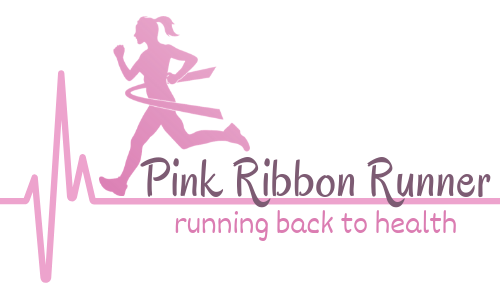
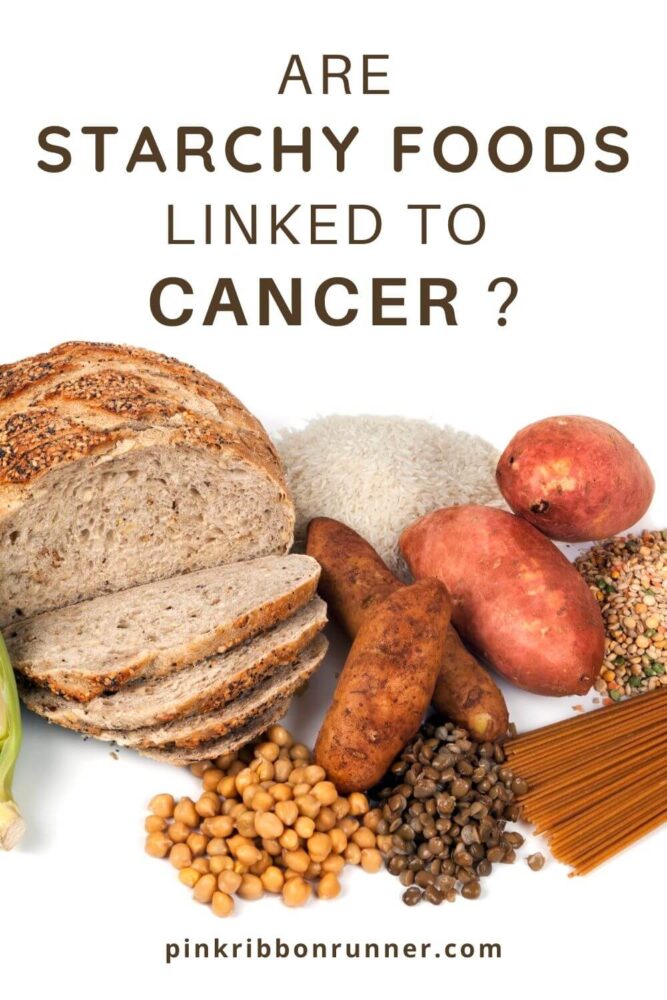

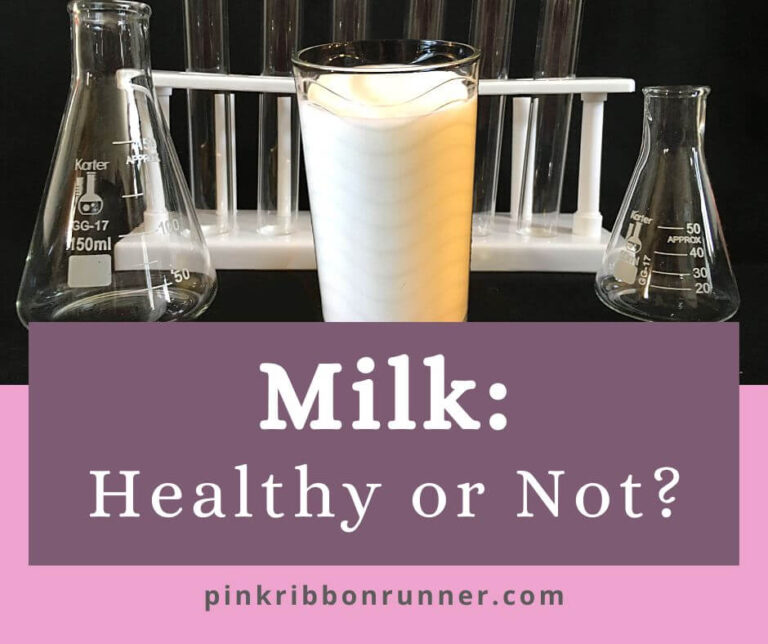





Can anyone tell me if sweet potato is higher on the G>I when cooked and eaten warm? Does it need to cool down like ordinary potatoes?
Also is wholewheat bread safe to eat?
Sweet potatoes have a lower GI of about 40 when raw. But when cooked, they have a medium GI at around 60 – 66, as the starches become more digestible. But even though the glycemic index is higher, these are a very healthy vegetable to eat. They are packed full of antioxidants and nutrients. Resistant starch does form when cooled, like with other potatoes. Unless you are diabetic, sweet potato are wonderful to eat raw, cooked or cooled. If you are diabetic or under the care of a registered dietician, then follow the more personalized advice of your dietician.
As for whole wheat bread… it is safe to eat in moderation. It contains more fiber than white bread, but is still a very starchy food. Because the wheat is ground in the milling process, the starches are more digestible and will raise blood sugar more easily. The glycemic index is about 55 – 70, depending on the brand and batch of flour used. White bread has a GI of about 70 or more. It is better to eat whole grain bread… the kind where you see the grains in it.
I hope this helps.
Thank you so much for sharing this. This is really helpful. I’m always confused by eating carbs/no carbs, because every diet says something else.
Oh, I know. It is so confusing. It is something that is talked about multiple times a day in my world. That is why I wanted to write these posts… to help clear up the confusion. Thank you for taking the time to comment.